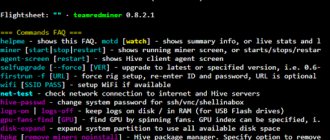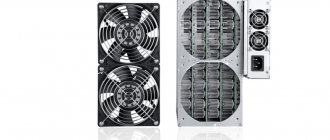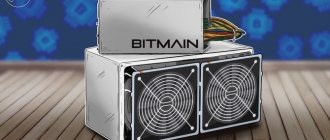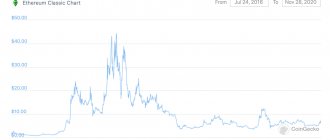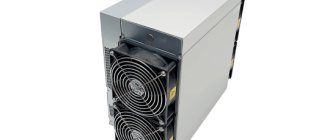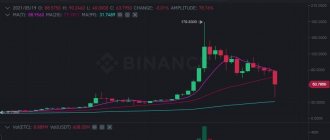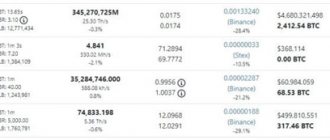As usual, let's start with an explanation. Initially, Antminer E3 stopped mining Ethereum Classic due to the growth of its DAG file, that is, a block of data that is loaded into the device’s memory when the miner starts. Since this model contains 4 GB memory chips, it simply did not have enough capacity to mine ETC.
A lot has changed this year. In August 2022, Ethereum Classic became the victim of several 51 percent attacks, which resulted in serious losses for miners. As a result, to improve the security of the project, its developers decided to change the cryptocurrency mining algorithm. The changes were introduced into the network at the end of November - that’s when ETC switched from Ethash to the new Etchash algorithm.
ASIC from Bitmain
A feature of the latter is compatibility with weaker 3 and 4 GB video cards. This means that the characteristics of Antminer E3 are now more than sufficient for mining Ethereum Classic. The only obstacle was the new algorithm, which ASICs usually don’t get along with, because they are initially created for certain algorithms. Fortunately, this problem has now been resolved.
ASIC for Ethereum - what is it, technical part
ASIC ETH (from the English phrase ApplicationSpecificIntegratedCircuit) is a device designed to perform cryptographic calculations associated with mining digital currencies using one or more encryption algorithms. ASICs use integrated circuits designed to perform the most efficient calculations of specified hashing functions, as well as specially designed housings and a cooling system.
They have the following advantages:
- high hashrate;
- quick start;
- ease of care;
- low power consumption per unit of computing power compared to other devices, such as video cards and processors;
- The presence of a reinforced housing and a powerful cooling system facilitates installation and connection of equipment.
At the same time, they have a number of disadvantages:
- impossibility of calculations using algorithms different from those provided by the manufacturer;
- increased noise and heat generation typical of high-performance server equipment and even more;
- powerful ASICs require the purchase of a separate power supply;
- it is difficult to find specialists and components for their repair;
- the potential to be included in the list of equipment that has regulatory restrictions regarding the use of information encryption devices;
- fairly rapid obsolescence and impossibility of selling equipment after a significant increase in the complexity of mining, which reduces profitability. Unlike ASICs, mining farms on video cards retain residual value even when the profitability of mining falls, and therefore can be sold as computer equipment.
When will Antminer E3 stop mining Ethereum?
In the near future, mining Ethereum Classic at E3 will not be possible even with a third of the hashrate. But what will happen to regular Ethereum? Again we turn to the size of the DAG file for help.
DAG file size for Ethereum, Ethereum Classic and other cryptocurrencies. Source: investoon.com
Ethereum is ten epochs behind Ethereum Classic. This means that when ETH also reaches epoch 328, Antminer E3 will have problems with it too. Since each epoch is 30 thousand blocks or 5 days [the average time to mine one block in the ETH and ETC networks is 13 seconds - editor's note], then ten epochs will take 45-50 days from today, February 24th.
That is, Antminer E3 will not be able to normally mine Ethereum ETH in just a month and a half - by April 8th.
From here we make two predictions:
- ASIC owners will have to switch to other Ethash coins. Since ASICs are not suitable for other tasks - which we emphasized back in 2022 - miners have no choice;
- After leaving the ETH and ETC networks, their hashrate will probably drop. Accordingly, owners of farms using video cards will earn more after this.
War of ASICs with video cards. Source: 2Bitcoin
ASIC for Ethereum: main selection parameters
Like any other mining equipment, when choosing ASICs for the consumer, the most important parameters are the following:
- price;
- performance (hashrate),
- mining algorithm;
- profitability and payback periods;
- complexity of connection and operation;
- power consumption;
- noise level;
- warranty period and availability of repair service;
- other, less important indicators, for example, weight, size and others.
One of the options for mining cryptocurrencies is renting ASICs. You can buy computing power on a cloud service, or rent equipment from local suppliers. When concluding a contract for cloud mining, you need to beware of scammers, and when looking for ASICs to rent from local companies, you need to take into account that no one will rent out profitable equipment, because it is more profitable to use it for your own needs.
Is it profitable to use an ASIC miner for Ethereum?
Before purchasing ASIC ETH, you need to familiarize yourself with all its functions, and also try to calculate the profitability and payback of the equipment. In addition, you need to take into account the overclocking capabilities of the ASIC. Special firmware has been created for many devices.
The firmware will allow you to increase your income and stay in the black. Here are the main functions of custom firmware:
- increase in hashrate with a minimal increase in power consumption;
- increasing hashrate to the maximum with increasing power consumption;
- reducing power consumption while maintaining hashrate (downvolt).
Remember that ASICs do not know how to switch between different mining algorithms. That is, you must decide in advance what cryptocurrency you are going to mine and purchase equipment specifically for it. Often miners choose either Bitcoin or Ethereum.
Video cards, on the contrary, can easily switch from one algorithm to another. Some programs can even automatically determine the most profitable cryptocurrency for mining and connect to the desired pool (for example, NiceHash). Of course, this cannot be done with ASICs.
ASICs Etherium: what kind of ASICs there are for mining Ethereum
The American company Nvminer has released ASIC miners for mining the Ethereum cryptocurrency with the following indicators:
NVMiner X8:
- hashrate for Ethereum – 265 MH/s;
- hashrate for ZCash - 2240 sol/s;
- chip - NVIDIA GP104;
- electricity consumption - 600-750w.
NVMiner X12:
- hashrate for Ethereum – 400 MH/s;
- hashrate for ZCash - 3400 sol/s;
- chip - NVIDIA GP104;
- electricity consumption - 850-950w.
These models are based on NVIDIA GP104 chips, which act as substitutes for conventional video cards. From the name it is clear that the device contains 8 or 12 such chips. Each has 6 GB of memory on board. In addition, there is a separate RAM (its volume is 4 GB), its own Intel Atom C2508 processor and even an SSD drive. Essentially, these are ordinary mining rigs that look like ASICs. Ethereum is well mined on video cards, so due to the popularity and profitability of this topic, specialized devices on chips appeared.
A popular product from Bitmain (Antminer for Ethereum) has the following characteristics:
- name - Antminer E3
- hashrate for Ethereum – 180 MH/s;
- electricity consumption – 800 w.
For EHT mining, Antminer E3 is not the worst, but not the top solution either. In February 2022, many miners regretted investing in Antminer. Ethereum has ceased to be mined on this device. The fact is that miners have to download a large DAG file before starting mining. The size of this file increases with each new epoch of the algorithm. As a result, due to memory limitations, Antminer E3 could no longer mine cryptocurrency. Almost a year later, in February 2022, the device returned to mining thanks to new firmware.
At the end of April 2022, the Chinese company Bitmain released a teaser of its new cryptocurrency “mine” Antminer E9, which provides Ethereum hashing speeds of up to 3 Ghash/s, which is equivalent to 32 NVIDIA GeForce RTX 3080 video cards. Today, Antminer E9 is the fastest ASIC miner available , surpassing even the Linzhi Phoenix Ethash ASIC, which has a speed of 2.6 Ghash/s. The price of such a device will range from $12,000 to $15,000. However, the profitability of the device at the current exchange rate will be $241 per day. This will allow you to pay for the equipment in just 2 months. What can I say, this is a really powerful ASIC. Etherium may still rise in price, which will make miners’ profits even greater, but equipment will also become more expensive against this background.
It is also worth paying attention to the Chinese company INNOSILICON. A10 ETH Master is the company’s debut ASIC miner. A10 ETH Master is available in three versions: 365, 432 and 485 MH/s. In 2022, Innosilicon A11 was released with the following characteristics:
- hashrate - 2100 MH/s ± 10 percent;
- consumption - 2300 W;
- memory capacity - 8 GB;
Are Bitmain Antminer E3 Ethash Legacy Miners?
Information about the material Published: 02/29/2020, 05:44
It seems that the life of ASIC miners Antminer E3 from Bitmain, which mine coins using the Ethash algorithm, is gradually coming to an end. According to reviews from many users of these devices, they are already unable to mine Ethereum Classic (ETC), and soon the same fate will befall Ethereum (ETH). The reason for this is the fact that these devices work like 4 GB video cards. video memory on board, and as soon as a 4GB video card cannot mine a particular coin using the Ethash algorithm (Dagger-hashimoto), then Antminer E3 will also not be able to mine it. Such obsolescence of devices (both GPU and ASIC) occurs due to the constant increase in the size of the DAG file, which is necessary for mining using the Ethash algorithm and which must be loaded into the memory of the video card or ASIC miner to be able to mine.
The Ethereum Classic coin became the first that Antminer E3 is no longer able to mine, since it is about 10 epochs ahead of regular Ethereum (epoch 328 for ETC and epoch 318 for ETH). Therefore, it is safe to say that Ethereum has approximately 2 months left before the Bitmain Antminer E3 will no longer be able to mine it.
Of course, there are many other, less popular coins that are also mined using the Ethash algorithm and are significantly behind ETC and ETH in terms of epochs and DAG file size, so Antminer E3 miners may not be completely useless after two months. However, the problem is that small mining capacities are currently concentrated on such, not very popular coins. And as soon as Bitmain Antminer E3 is unable to mine Ethereum (where the network hashrate is orders of magnitude higher), they will all switch to these “small” coins, significantly reducing the profitability of their mining. In addition, as a rule, all these numerous Ethereum forks have small trading volumes, which is not very good for large mining farms where Antminer E3 ASICs are installed.
Another interesting fact is that this year the developers of Ethereum (ETH) have a plan to carry out another hard fork and switch Ethereum mining to the ProgPow algorithm (mining only on GPU).
From all this it follows that now is not a very good time to buy Bitmain Antminer E3, even if you find an offer for sale at really low prices, since in less than two months it may become practically useless and you risk never recouping your investment in such a thing equipment. If you own such devices, make sure you make the most of them during the remaining time and start planning what you will do with them later.
- Mining equipment
Ethereum ASIC: how profitable is it to use the device?
In order to understand how profitable mining is, you can calculate profitability on special calculator sites. For example, on Innosilicon A 10 PRO 6G, with a power of 500 MH/s, you can get $39.5 per day. With an ASIC cost of 300,000 - 400,000 rubles, it will pay for itself in 3 - 4 months.
Antminer E3 at 190 MH/s will bring its owner $14 per day and at a cost of 80,000 - 120,000 rubles will pay for itself in 2.5 - 4 months. In principle, this is quite fast, considering that video cards at a similar cost have a hashrate that is 2 or even 4 times lower. For example, a Gigabyte GeForce RTX 3060 video card at a cost of 110,000 rubles will produce only 37 MH/s and will bring the owner only $4.5 per day, and will pay off in 11 months.
What happened to Antminer E3?
The last weekend was alarming for Antminer E3 owners: their devices suddenly dropped in hashrate when mining Ethereum Classic. The hashrate has decreased significantly - from 200 to 30 MH/s. Reboots and changing mining pools did not help - the hashrate still remained low. That is, the problem clearly lay in the ETC cryptocurrency itself.
ASIC miner for Ethereum mining. Source: 2Bitcoin
A little theory: the Ethash algorithm, which also powers Ethereum and Ethereum Classic, uses a so-called DAG file. This is a block of data that is loaded into the memory of video cards when the miner is launched. That is, it is thanks to it that GPUs find block solutions in Ethash coin networks and replenish miners’ balances.
The peculiarity is that the size of the DAG file increases over time. Volume growth occurs every 30 thousand blocks, and the procedure itself is known as “change of epoch”. Every epoch the file grows by 8 megabytes.
Here are the latest DAG file metrics for different cryptocurrencies as of today.
DAG file size for Ethereum, Ethereum Classic and other cryptocurrencies. Source: investoon.com
As soon as the file size reaches a critical value, which is equal to the memory capacity of video cards, the latter cease to cope with its extraction, that is, mining simply does not take place. A similar thing happened in December 2022, when the Nvidia GTX 1060 3 GB stopped mining ETH and ETC.
2Miners pool specialists came to the conclusion that Antminer E3 has the same problem. At the same time, ASIC miners usually do not encounter it - after all, ASICs for Ethash are more similar in their hardware to video cards, and they are still the exception rather than the rule. Of the well-known competitors, the only one that comes to mind is Innosilicon A10, the performance of which we recently got acquainted with in detail.
We contacted Bitmain representatives and received a response today. Jessica L. from the company's support team responded to us. The contents of the letter were as follows:
Thanks for your consultation!
Sorry for your inconvenience we got the confirm from technical department E3 miner is a 4G video card. E3 is related to eth algorithm, and DDR capacity is up to the upper limit, so E3 will not be able to continue mining.
the meaning is E3 only can mine to January 2022, then will not mine again
Please let us know if you have additional questions or concerns.
The fears were confirmed; inside the Antminer E3 there are video cards with 4 GB of memory. That is, this ASIC does not just depend on the size of the DAG file - it has already fallen overboard from Ethereum Classic mining. The device’s performance does not allow mining ETC, and this explains the significant drop in hashrate. As a Bitmain employee pointed out, Antminer E3 was supposed to be mined until January 2020.
Did the manufacturer warn about this in advance? No. That is, in essence, the miners bought a pig in a poke and are now left with a couple of tufts of wool. It will no longer be possible to mine ETC normally.
By the way, they bought it for a fairly high price. Antminer E3 was initially priced at $800 and then went up to $1,800. I wonder if the expenses have paid off over time? Although this is unlikely to bother anyone, because ASIC manufacturers only care about money.
ASIC miner for Ethereum mining. Source: 2Bitcoin
